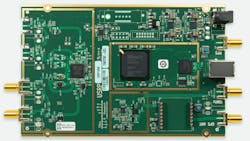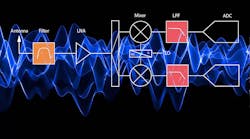2025’s Top Trends: Cognitive Radios Deftly Park Signals
What you’ll learn:
- Cognitive radio can provide the means to employ unoccupied spectrum.
- SDRs enhanced with AI technology lead to dynamically tunable radio systems in compact housings.
- Several manufacturers are already exploring this nascent melding of technologies.
Bandwidth for communications and other wireless applications is limited and being rapidly consumed by emerging applications. National organizations such as the Federal Communications Commission (FCC) closely monitor frequency spectrum within the electromagnetic (EM) range in attempts to minimize interference or problems from overlapping EM signals. But when frequency spectrum appears filled, innovative technologies like cognitive radio (CR) can provide the means to employ spectrum that’s otherwise unoccupied.
In a CR system, a transceiver detects when communications channels are being used or not. It instantly switches to unoccupied frequency spectrum while avoiding occupied channels. By moving to otherwise unused spectrum and eschewing occupied frequency ranges, CR systems feature increased spectrum efficiency compared to traditional wireless systems, with high quality of service (QoS) for its users.
In addition to the FCC helping to monitor commercial or non-federal radio users of EM bandwidth, the National Telecommunications and Information Administration (NTIA) checks on the radio use of frequency spectrum by government users, such as military troops. These bands aren't utilized with equal efficiencies since some bands, e.g., cellular radio bands, are overcrowded. Others, such as military radio bands, are often rarely used.
But as the number of wireless devices, including at higher frequencies, continues to climb, EM spectrum must be used intelligently. CR systems provide the means of filling otherwise unused frequency spectrum.
Cognitive Radio Melds Spread-Spectrum, Frequency-Hopping, and AI Technologies
CR systems combine several communications techniques, such as spread-spectrum radios and frequency-hopping radios, guided by artificial-intelligence (AI) technology to make efficient use of otherwise unoccupied frequency bandwidth.
A CR system operates within two switchable networks: a primary network and a secondary network. The primary network is a communication system’s licensed frequency band, while its secondary network is typically frequency spectrum unused by that CR system except when the licensed spectrum is occupied. A CR system features cognition and capabilities for reconfiguration and learning:
- Through cognition, the radio understands its geographical and operating environments.
- Through reconfiguration, the radio can autonomously and dynamically adjust for optimum operation under changing conditions.
- Through learning, a CR system can adapt to new situations.
To detect radio activity within a frequency range, a CR system performs spectrum sensing to identify licensed users. Spectrum sensing can also detect when holes exist within a defined frequency range, and a CR can make use of those frequency holes without a license. Spectrum sensing may be conducted cooperatively, in which spectrum information is shared among multiple CR devices, or non-cooperatively, in which each CR device acts on its own.
To further understand how available frequency spectrum is occupied, CRs check on the availability of the frequency spectrum according to a database maintained by the FCC. While this information, such as that used by commercial broadcast stations, is highly accurate, it may not be updated in a timely fashion. Thus, CRs may not always know of all available frequency spectrum.
Several types of CRs contribute to radio access networks (RANs), including heterogenous and spectrum-sharing CRs. Heterogeneous CRs operate via a network-centric approach, with multiple RANs having the same or different protocols and multiple fixed-frequency bands allocated to the RANs.
In spectrum-sharing CR systems, multiple RANs share the same frequency band, and they're tightly controlled for optimal use of available frequency bands. Heterogenous and spectrum-sharing CRs attempt to make optimum use of available bandwidth. CRs can also be categorized as full-cognitive or spectrum-sensing designs—the former uses as many CR sorting mechanisms as possible, while the latter works around established channels (such as television broadcast stations) in the frequency spectrum.
Finding Frequencies Using A/D-D/A Conversion and Spectrum Hopping
By enhancing software-defined radios (SDRs) with AI technology, CR developers can design dynamically tunable radio systems in compact housings. In an SDR, most radio parameters are adjustable by means of software control of the radio’s digital hardware. Received high-frequency analog signals are transformed into the digital realm by high-speed, high-resolution analog-to-digital converters (ADCs) and from digital back to the analog realm by high-speed digital-to-analog converters (DACs) for transmission.
High-speed microprocessors and field-programmable gate arrays (FPGAs) lend the processing power for programming an SDR’s center frequency and bandwidth, as well as parameters like frequency-hopping patterns and speeds. Not all designs are in the microwave range, as Thales recently announced its use of CR technology for a line of high-frequency (HF) radios capable of automatically switching frequency channels when dealing with jammers.
The Ettus Research model B210 Universal Software Radio (USRP) from the Ettus Research brand of National Instruments has become something of a reference design for SDR-based CRs. The MIMO radio operates over a continuous frequency range of 70 MHz to 6 GHz in a compact enclosure (Fig. 1). And the model RB210 SDR from Pixus Technologies is designed to fit into a ruggedized, weatherproof package measuring just 87 × 156 × 300 mm and weighing less than 7 lbs., with options for full military-grade versions.
The versions of the B210 and RB210 SDR/CR units leverage the model AD9361 direct-conversion transceiver IC from Analog Devices for as much as 56 MHz of real-time bandwidth across the wide frequency range. The wideband SDR/CR with its two receive and two transmit channels is a fit for many applications, including advanced wireless, radar, and SIGINT systems in airborne and ground vehicles, as well as shipboard and soldier-mounted platforms.
Single PCB for Experimenting with Cognitive Radio
For experimenters, Digilent offers its USRP B200 SDR/CR (Fig. 2) with one receive and one transmit channel on a single printed-circuit board (PCB). It provides continuous frequency coverage from 70 MHz to 6 GHz with as much as 56 MHz of instantaneous bandwidth. It also features a Universal Serial Bus (USB) SuperSpeed interface and 12-bit ADCs and DACs. This PCB version of the SDR/CR measures 9.7 × 15.5 × 1.5 cm and weighs just 350 g. It's powered by a standard USB 3.0 connection and an accessory kit is available for assembling a compact enclosure.
For those in need of two receive and two transmit channels on a PCB, the company’s model USRP B210 is a four-channel version with a +6-V DC power supply. Because its processing power extends across two additional channels, the instantaneous bandwidth per channel drops to 30.72 MHz for each of the four channels across the same frequency range. The four-channel SDR/CR provides fully coherent 2 × 2 MIMO capability with full- or half-duplex communications channels.
While CR technology has room for growth, especially at higher signal frequencies where more spectrum is available, its innovative use of digital technology clears the way for the intelligent radios needed for many markets, especially medical applications.
Numerous medical facilities have explored the use of SDRs for monitoring patients with serious health issues without any interruptions in the communications links. Fueled by AI and ML technologies, SDR/CR equipment can provide continuous coverage with the intelligence to alert medical professionals according to critical signs and symptoms.
Learn more about technology trends
About the Author
Jack Browne
Technical Contributor
Jack Browne, Technical Contributor, has worked in technical publishing for over 30 years. He managed the content and production of three technical journals while at the American Institute of Physics, including Medical Physics and the Journal of Vacuum Science & Technology. He has been a Publisher and Editor for Penton Media, started the firm’s Wireless Symposium & Exhibition trade show in 1993, and currently serves as Technical Contributor for that company's Microwaves & RF magazine. Browne, who holds a BS in Mathematics from City College of New York and BA degrees in English and Philosophy from Fordham University, is a member of the IEEE.





